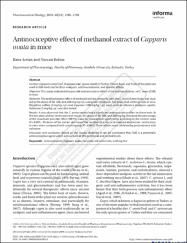Antinociceptive effect of methanol extract of Capparis ovata in mice
Özet
Context: Capparis ovata Desf. (Capparaceae) grows widely in Turkey. Flower buds and fruits of the plant are used in folk medicine for their analgesic, antirheumatismal, and diuretic effects. Objective:This study evaluated the possible antinociceptive effect of the methanol extract of C. ovata (CME) in mice. Materials:The antinociceptive effect of methanol extract, prepared with the C. ovata flower buds, was studied at the doses of 50, 100, and 200 mg/kg (i.p.) using tail-immersion, hot-plate, and writhing tests in mice. Morphine sulfate (5 mg/kg; i.p.) and dipyrone (100 mg/kg; i.p.) were used as reference analgesic agents. Naloxone (5 mg/kg; i.p.) was also tested. Results: It was observed that the C. ovata extract had a significant antinociceptive effect in these tests. In the hot-plate and tail-immersion test results, the doses of 50, 100, and 200 mg/kg increased the percentage of the maximum possible effect (MPE%) value for nociception significantly according to the control value (P < 0.001). All doses of the extract decreased the number of acetic acid-induced abdominal constrictions in mice when compared with control group (P < 0.001). These effects were inhibited by pretreatment with naloxone. Discussion and conclusion: Based on the results obtained, it can be concluded that CME is a potentially antinociceptive agent which acts as both at the peripheral and central levels.


















